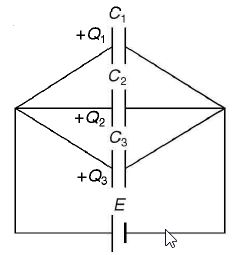Electrical Engineering ⇒ Topic : Capacitors in Parallel
|
|
| Peter
| |
Capacitors in Parallel Consider three capacitors, having capacitances C1, C2 and C3 farad respectively, connected in parallel across a p.d. of r volts [See Figure (a) (i)]. In parallel connection, p.d. across each capacitor is the same but charge on each is different
figure (a)
But Q/V is the total capacitance CT of the parallel combination [See Fig (a). (ii)] CT = C1 + C2 + C3 Thus capacitors in parallel are treated in the same manner as are resistors in series.
| |
|
| |
| Maninder
| |
CAPACITORS IN PARALLEL In this case, the charge on each capacitor is different but voltage is same as shown in Figure (a). The total charge Q is given by Figure (a) Capacitors connected in parall
When n capacitors C1, C2, , and Cn are in parallel, it can be expressed as: | |
|
| |
| Lalan
| |
Capacitors in Parallel:- Figure shows the arrangement of capacitors in parallel. C1, C2 and C3 are the three capacitors connected in parallel. The voltage across each capacitor is the same, i.e. V volts. Let .q1, q2 and q3 be the corresponding charges on C1, C2and C3. We know that q1= C2 V q2= C2V q3= C3V
Arrangement of capacitors in parallel The total charge on the system of capacitors is given as Therefore, the equivalent capacitance C is given as The above equation suggests that the system of parallel capacitors can be represented by a single equivalent capacitor whose capacitance is the sum of the three individual capacitors. Similarly, if the parallel combination contains n capacitors, then Thus, in the parallel system of arrangement of capacitors, the equivalent capacitance (C) is always greater than any individual capacitance and is equal to the sum of all the capacitances connected in parallel. | |
|
| |
!! OOPS Login [Click here] is required for more results / answer





 ............ (1)
............ (1)